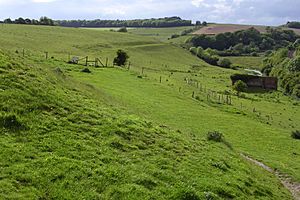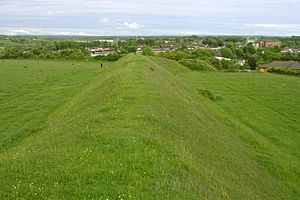Poundbury Hill facts for kids
Poundbury Hill is an ancient hill fort in England. It's located near the town of Dorchester, Dorset. This fort was built during the Middle Bronze Age, which was a very long time ago! It's shaped like a rectangle and was probably used to watch over the River Frome valley. The main way into the fort was from the eastern side.
Contents
Discovering Poundbury Hill's Secrets
Archaeologists first started digging at Poundbury Hill in 1938. They found out how the fort was built and changed over many years. Around 400 BC, the fort's banks were made stronger with wood. A deep, V-shaped ditch was also dug around it. Later, around 50 BC, the banks were made even bigger. A strong wall of limestone was added to support them.
Important Places Near the Fort
The Ancient Cemetery
Just outside the fort, on its northeast side, was a very large Romano-British cemetery. This was a burial ground used by people living in Roman times. Most of the burials found here are from the 4th century AD. However, people used this cemetery for a very long time, from the Stone Age all the way to the Middle Ages. Archaeologists dug up this cemetery in the 1970s.
The Roman Waterway (Aqueduct)
The outer walls of the hill fort were partly damaged when the Roman aqueduct was built. This aqueduct was a special channel that brought fresh water to the Roman town of Durnovaria (which is now Dorchester). The water came from a reservoir about 4.5 km (2.8 mi) away.
The aqueduct followed a winding path almost 9 km (5.6 mi) long. It had a very gentle slope, which helped the water flow. The channel was small, about 80 cm wide and 30 cm deep. It had a clay bottom and wooden sides, with a wooden cover. Soil and grass were placed on top to keep the water clean. This water was used for the town and its public baths. The aqueduct stopped being used around 160 AD after the reservoir dam broke.
The Railway Tunnel
The main railway line that goes from Dorchester to Yeovil (now called the Heart of Wessex Line) was built under Poundbury Hill. This was done to avoid damaging the old fort's walls. The famous engineer Brunel first wanted to dig a deep trench through the fort. But local people were very upset about this plan. Their protests led to the more expensive tunnel being built instead. This protest also helped create the Dorset archaeological society, which works to protect historical sites.




